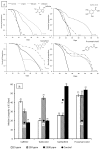Dietary Phytochemicals, Honey Bee Longevity and Pathogen Tolerance
- PMID: 30626025
- PMCID: PMC6359238
- DOI: 10.3390/insects10010014
Dietary Phytochemicals, Honey Bee Longevity and Pathogen Tolerance
Abstract
Continued loss of natural habitats with native prairies and wildflower patches is eliminating diverse sources of pollen, nectar and phytochemicals therein for foraging bees. The longstanding plant-pollinator mutualism reiterates the role of phytochemicals in sustaining plant-pollinator relationship and promoting honey bee health. We studied the effects of four phytochemicals-caffeine, gallic acid, kaempferol and p-coumaric acid, on survival and pathogen tolerance in the European honey bee, Apis mellifera (L.). We recorded longevity of worker bees that were provided ad libitum access to sugar solution supplemented with different concentrations of phytochemicals. We artificially infected worker bees with the protozoan parasite, Nosema ceranae. Infected bees were provided access to the same concentrations of the phytochemicals in the sugar solution, and their longevity and spore load at mortality were determined. Bees supplemented with dietary phytochemicals survived longer and lower concentrations were generally more beneficial. Dietary phytochemicals enabled bees to combat infection as seen by reduced spore-load at mortality. Many of the phytochemicals are plant defense compounds that pollinators have evolved to tolerate and derive benefits from. Our findings support the chemical bases of co-evolutionary interactions and reiterate the importance of diversity in floral nutrition sources to sustain healthy honey bee populations by strengthening the natural mutualistic relationships.
Keywords: Apis mellifera; Nosema ceranae; honey bees; nectar; phytochemicals; plant-pollinator interactions.
Conflict of interest statement
The authors declare no conflict of interest. The funding sponsors had no role in the design of the study; in the collection, analyses, or interpretation of data; in the writing of the manuscript, and in the decision to publish the results.
Figures


References
Grants and funding
LinkOut - more resources
Full Text Sources

